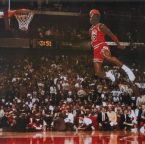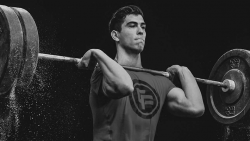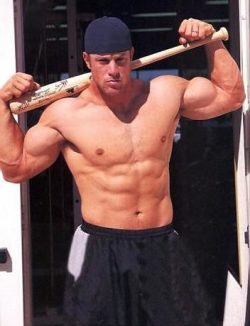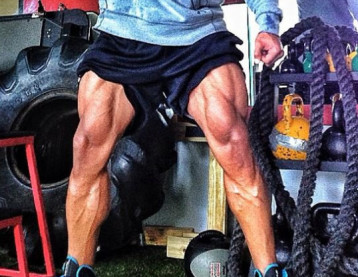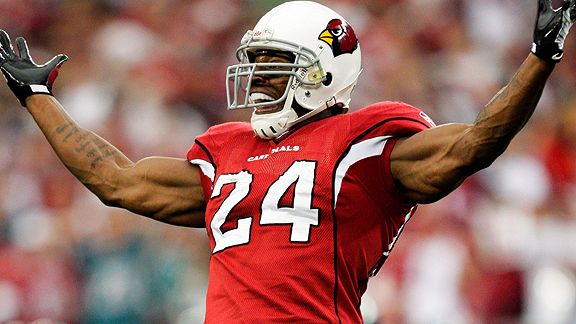Volleyball is a sport where an athlete’s vertical jump can make all the difference in performance, whether blocking, attacking, or making a great defensive save. The success of a volleyball player depends a lot on the right training, and it’s essential for athletes to get the right type of volleyball training.
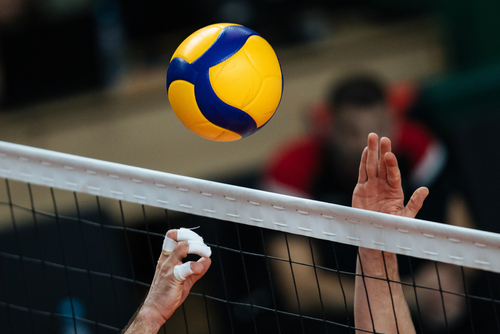
They must develop basic volleyball skills such as hitting, passing, setting, digging, and blocking. Here are three components necessary to elevate your vertical to its highest potential.
- Power
- Jump form
- Comfortability.
Volleyball practices always have to begin with warm-up exercises. Here are some exercises to perform before the game:
- 15 Minutes of Cardio – Warm up first
- 15 Knee Tuck Jumps
- 15 Lateral Jumps
- 15 Mountain Climbers
- 15 Broad Jumps
- 15 Burpees
- 15 Squat Jacks
- 15 Agility Dots
- 15 Squats Jumps
- Cool Down and Stretch
What type of training is best for volleyball?
The answer to this question depends on your goals and what you’re trying to improve. If you’re just starting out, it’s important to focus on the basics and develop a solid foundation. Once you have that, you can start adding more advanced techniques to your repertoire.
If you’re looking to improve specific skills, drills are a great way to do that. You can get the most out of your training by isolating the skill you’re trying to improve. For example, if you’re looking to improve your serve, you might want to focus on drills that help you with your serves.
Volleyball training should be tailored to your individual needs and goals. By working with a coach or trainer, you can develop a plan that will help you reach your full potential. With the right training, you can take your game to the next level and dominate the court.
Basic speed and agility volleyball training drills
1. Lateral Shuffle
Instructions: Start by standing on one side of the court. Take a small step to the right with your right foot, then quickly follow it with your left foot. Continue shuffling to the right until you reach the other side of the court. Reverse direction and shuffle to the left. Repeat for 30 seconds.
2. Backpedal
Instructions: Start by standing at one end of the court. Step backwards with your right foot, then quickly follow it with your left foot. Continue backpedaling until you reach the other end of the court. Repeat for 30 seconds.
3. Side Shuffle
Instructions: Start by standing on one side of the court. Take a small step to the right with your right foot, then quickly follow it with your left foot. Immediately after, take a small step to the left with your left foot, then quickly follow it with your right foot. Continue shuffling from side to side until you reach the other end of the court. Repeat for 30 seconds.
4. Carioca
Instructions: Start by standing on one side of the court. Cross your right foot behind your left foot, then step to the left with your left foot. Immediately after, cross your left foot behind your right foot and step to the right with your right foot. Continue moving from side to side, crossing your feet behind each other. Repeat for 30 seconds.
5. High Knees
Instructions: Start by standing in one place. Bring your right knee up towards your chest, then quickly lower it back down and bring your left knee up towards your chest. Continue alternating legs as fast as you can. Repeat for 30 seconds.
6. Butt Kicks
Instructions: Start by standing in one place. Bring your right heel up towards your butt, then quickly lower it back down and bring your left heel up towards your butt. Continue alternating legs as fast as you can. Repeat for 30 seconds
7. Skaters
Instructions: Start by standing on one side of the court. Jump to the right, landing on your right foot and bringing your left leg behind you. Immediately jump to the left, landing on your left foot and bringing your right leg behind you. Continue jumping from side to side as quickly as you can. Repeat for 30 seconds.
The Vertical Jump for Volleyball
There has been a lot of talk about the importance of a high vertical jump in the sport of volleyball. It’s worth noting that a hitter’s success depends greatly on his/her vertical jump. A player who can consistently jump higher than his/her opponents will likely have an advantage on the court.
That being said, vertical jump training is not specific to volleyball and can be beneficial for any athlete looking to improve their explosiveness. Below are some basic exercises that will help you build lower-body strength and improve your vertical jump.
1. Squats
Instructions: Start by standing with your feet shoulder-width apart. Lower your body down into a squat position, then explosively stand back up. Repeat for 10-12 repetitions.
2. Lunges
Instructions: Start by standing with your feet together. Step forward with your right leg and lower your body down into a lunge position. Be sure to keep your front knee from extending past your toes. explosively stand back up and repeat with your left leg. Alternate legs for 10-12 repetitions.
3. Calf Raises
Instructions: Start by standing with your feet shoulder-width apart. Raise up onto your toes, then slowly lower yourself back down. Repeat for 10-12 repetitions.
4. Jump Squats
Instructions: Start by standing with your feet shoulder-width apart. Lower your body down into a squat position, then explosively jump up as high as you can. Land softly and immediately squat back down and jump again. Repeat for 10-12 repetitions.
5. Box Jumps
Instructions: Find a sturdy box or platform that is about knee-height. Stand in front of the box, then explosively jump up onto it. Step down and repeat for 10-12 repetitions.
These are just a few basic exercises that will help you improve your vertical jump. Remember to focus on quality over quantity and always use proper form. If you have any questions, be sure to consult with a qualified strength and conditioning coach.
Related: The Best Jumping Exercises for Athletes
Arm Swing -Volleyball Hitting Drills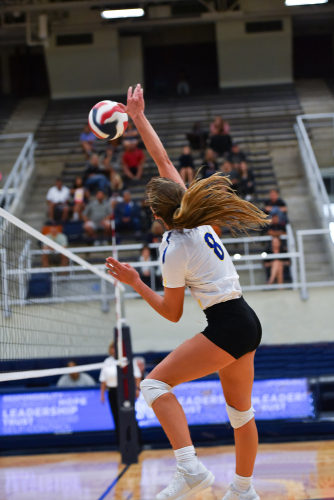
An arm swing is a key element of an attack in the game of volleyball. A volleyball player should aim to make a fast arm swing to carry out a powerful spike and land the ball on the opposite side of the court successfully.
Here are some drills that can help a player develop a fast arm swing and become a more powerful hitter.
1. Wall Bounces
Instructions: Start by standing in front of a wall with your feet shoulder-width apart. Place your non-dominant hand on the wall for support. Bounce a volleyball off the wall using your dominant hand. Start with soft bounces and gradually increase the force of your bounces. Repeat for 30 seconds.
2. Medicine Ball Throws
Instructions: Start by standing with your feet shoulder-width apart. Hold a medicine ball in both hands at chest level. explosively throw the ball against a wall. Catch the ball and repeat for 10-12 repetitions.
3. Resistance Band Pulls
Instructions: Start by standing with your feet shoulder-width apart. Step on a resistance band and hold the ends in each hand. explosively pull the band apart, then release and allow it to snap back. Repeat for 10-12 repetitions.
4. Dumbbell Shoulder Press
Instructions: Start by standing with your feet shoulder-width apart. Hold a dumbbell in each hand at shoulder level. explosively press the dumbbells overhead, then lower back down to shoulder level. Repeat for 10-12 repetitions.
5. Plyometric Push-ups
Instructions: Start in a push-up position with your hands shoulder-width apart. Lower your body down, then explosively push up so that your hands leave the ground. Land softly and repeat for 10-12 repetitions.
These drills will help you develop explosive power in your arms and shoulders, which is essential for hitting
Contact of the Ball in Volleyball
The way you contact the ball matters a lot for a hitter in volleyball. It’s necessary to contact the ball in the right way. It would be better for a volleyball hitter to contact the ball at the peak point.
A hitter should position their arm correctly to contact the ball successfully. Hitter’s hands have to be straight. So, the palm is down during contact with a ball. A volleyball hitter should aim to contact the ball with their fingertips.
Contact the ball in front of your hitting shoulder. In this case, a hitter will have a better chance to successfully land the ball on the opposite side of the court. Keep in mind that resisting a hard-driven ball can be hard.
Volleyball Blocking Drills
Blocking is an important part of the game of volleyball. A player should aim to get their hands above the net and make a firm block to stop the ball from going over on the other side.
Here are some drills that can help a player develop their blocking skills.
1. Hands-Only Blocking
Instructions: Start by standing in front of a net with your feet shoulder-width apart. Raise your hands above the net and maintain a firm grip. Use your hands to block the ball back and forth over the net. Repeat for 30 seconds.
2. Two-Handed Blocking
Instructions: Start by standing in front of a net with your feet shoulder-width apart. Raise your hands above the net and grip the ball with both hands. Use your hands to block the ball back and forth over the net. Repeat for 30 seconds.
3. Forearm Passes
Instructions: Start by standing in front of a net with your feet shoulder-width apart. Raise your forearms above the net and grip the ball with both hands. Use your forearms to pass the ball back and forth over the net. Repeat for 30 seconds.
4. Overhead Passes
Instructions: Start by standing in front of a net with your feet shoulder-width apart. Raise your arms above the net and grip the ball with both hands. Use your arms to pass the ball back and forth over the net. Repeat for 30 seconds.
5. Jumping Jacks
Instructions: Start by standing with your feet together and your arms at your sides. explosively jump up and spread your legs out to the sides. As you land, bring your legs back together and reach your arms overhead. Repeat for 10-12 repetitions.
These drills will help you develop the coordination and strength necessary to make a solid block. Remember to focus on quality over quantity and always use proper form. If you have any questions, be sure to consult with a qualified volleyball coach.
Volleyball Attacking Skills
A volleyball team has to carry out an attack to earn points during the game. Volleyball attacking is one of the basic volleyball skills. Attacking skills are as crucial as blocking, digging, passing, setting and serving. It’s one of the skills that volleyball players have to master.
A need to hit the ball may arise anytime during the game of volleyball. That’s why every volleyball player must learn how to attack.
A hitter is a key volleyball player on the court. The main job of an attacker in volleyball is to hit the ball. An attacker should aim to hit the ball forcefully and, most importantly, precisely. By doing so, a volleyball hitter will make it difficult to resist an attack hit.
A volleyball player should do their best to land the ball on the opposite side of the court. A good hitter can contribute significantly to the success of their volleyball teams. If a hitter does their job successfully, they will help a volleyball team earn more points and win the game.
A hitter should develop the correct type of volleyball skills to do a great job on the court. We’ll explain how to attack in volleyball correctly and what it takes to be a good volleyball hitter.
So, let’s get started.
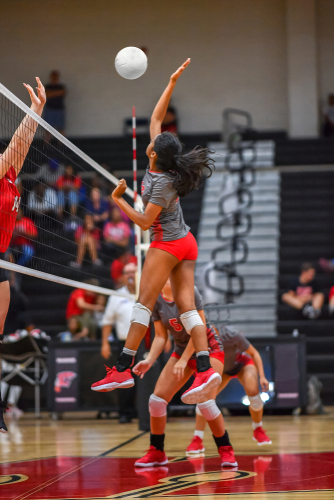
An Attack Approach
The success of a volleyball hitter depends a lot on their footwork. A hitter should use the right-step approach to get to the ball and then carry out an attack hit.
First and foremost, a volleyball player should approach to the ball as soon as possible. A volleyball hitter should start moving towards the ball once they see that the moment to carry out an attack hit will come quickly. That’s why it’s so important for a volleyball hitter to move fast on the court. In other words, a hitter has to work on an attack approach.
Initially, a volleyball player should take the proper body position. Take a small step forward, put your weight down and then make an explosive movement to take off the ground. Finally, you must take a quick right-left step simultaneously and land on the court. The angle between a volleyball player and the net has to be 45 degrees.
At the next step, a volleyball hitter has to relax and put their body down. The volleyball player’s arms should be back. From this position, volleyball players find it easy to go up and carry out an attack hit. That means that a hitter can get to the ball quickly if they master such an approach.
Volleyball Workout Program
Below is a general volleyball workout program that will help you excel on the court.
Monday:
- Warm-up: 10 minutes of jogging or jumping jacks
- Strength training: 3 sets of 12 reps of squats, lunges, and leg press
- Plyometrics: 3 sets of 10 reps of box jumps and jump squats
- Core: 3 sets of 20 reps of planks, Russian twists, and leg raises
Tuesday:
- Warm-up: 10 minutes of jumping rope
- Speed and agility: 3 sets of ladder drills and agility cones
- Upper body: 3 sets of 12 reps of push-ups, pull-ups, and dumbbell rows
- Cardio: 30 minutes of running or cycling
Wednesday: Rest
Thursday:
- Warm-up: 10 minutes of jumping jacks or high knees
- Balance and stability: 3 sets of 10 reps of single-leg deadlifts and Bosu ball exercises
- Hitting and blocking: 3 sets of 10 reps of overhead slams and wall blocks
- Flexibility: 30 minutes of yoga or stretching
Friday:
- Warm-up: 10 minutes of running or jogging
- Endurance: 3 sets of 30 seconds of stair sprints and jump rope
- Defense: 3 sets of 10 reps of diving and sliding drills
- Core: 3 sets of 20 reps of Russian twists and leg raises
Saturday and Sunday: Rest
Note: This is a sample program and it can be adjusted to your own fitness level and schedule. It’s also important to consult with your doctor before starting any new exercise program.
Final Thoughts
A hitter has to put particular focus on developing volleyball attacking skills. It’s also important to note that an attacker should aim to master different types of hits in volleyball. Every situation requires a certain type of attack hit. So, it would be better for a hitter to be a versatile volleyball player.
Working on volleyball attacking skills helps hitters develop an effective hitting technique that works well for any situation. Volleyball hitters should do the drills that allow them to develop their attacking skills efficiently.
There are many great volleyball attacking drills. These include: high contact drill, team approach jump drill, game simulated hitting drill, pass set hit drill, ball control with back row attack drill, spike approach drill, as well as wall spike drill. No doubt, doing drills of this type will help volleyball players develop their attacking drills successfully. Train hard, train smart, and train regularly to become a better volleyball hitter for your team. Your success is inevitable!

Wayne Mutata is the owner of iTrainStudio and is dedicated to helping individuals reach their health and fitness goals. As a personal trainer, nutritionist, leader, and motivator, he brings light into the Studio every day and positively influences those around him. You can follow him on Facebook at @iTrainStudio and on Instagram at @iTrainWithWayne or @iTrainStudio.Lancaster. For a free consultation, visit theiTrainStudio website!


